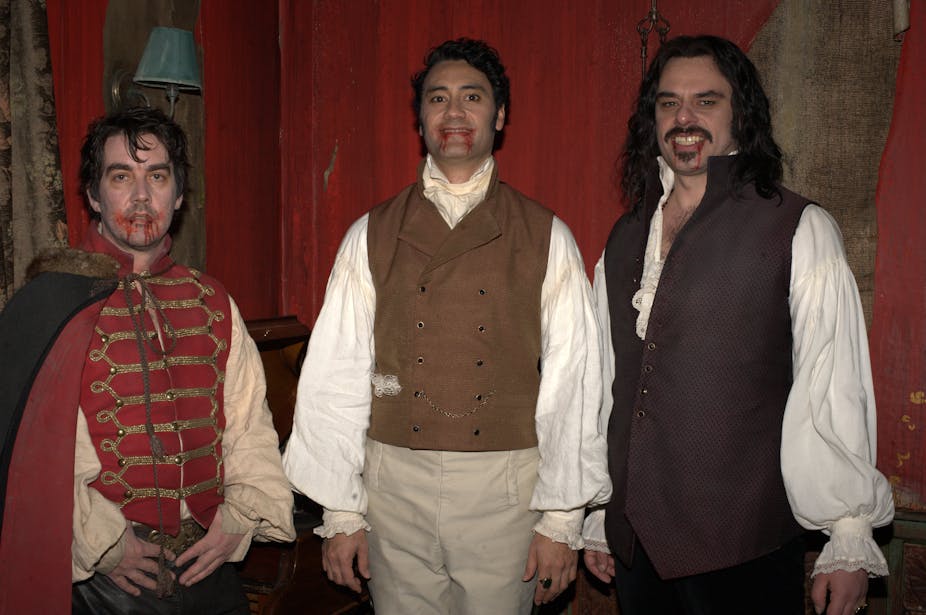Yes, some vampires like to live in looming, crumbling, cobwebby castles. But some, the vampires of What We Do in the Shadows, a New Zealand film released today, like to live in flats in Wellington. This new vampire film, written and directed by Jemaine Clement of Flight of the Conchords fame and Taika Waititi, relies on the contrast between the classic, Gothic vampire and the mundane realities of everyday life in New Zealand to generate its quirky, deadpan humour.
Spoofing the spooky
A mockumentary in the tradition of Spinal Tap and Borat, What We Do in the Shadows tells the behind-the-scenes story of four vampires as they prepare for “The Unholy Masquerade”.
In shaping their peculiar coven of flatmates, Clement and Waititi parody several iconic vampires. There is Vladislav “The Poker” (Clement), styled after Dracula, or Vlad, the Impaler; Petyr (Ben Fransham), a frightful 8,000 year old monster after Murnau’s nosferatu Count Orlock; Viago (Waititi), a fastidious 18th century dandy after Anne Rice’s Louis and Lestat; and Deacon (Jonathan Brugh), whose “erotic” dance moves undermine the sexiness of vampires everywhere.
The obvious disparities between these vampires result in delightfully petty conflicts within their flat.

This odd family becomes odder still with the addition of Nick (Cori Gonzalez Macuer), a recently-turned vampire who (unfortunately) likes to brag in public about his new demonic powers. Nick introduces our ancient vampires to the marvels of 20th-century technology, bringing along his scene-stealing, human best friend Stu (played by real-life IT guy, Stu Rutherford).
Vampires: so hot right now
The idea for the film originated back in 2005 when, as Waititi explained at last night’s Australian premiere in Melbourne, nobody was really making vampire films.
His comment needed no further explanation to make the audience laugh. After all, since 2005 we have been buried by the undead who refuse to remain in their graves. In the last decade, vampires have been ubiquitous in popular film, television and fiction.
But this recent popularity is surely more fortunate than unfortunate for a vampire mockumentary, which relies on its audience’s ability to recognise parodic and intertextual humour. Far from being badly-timed, this film needs the audience to be in on the jokes, and that means knowing the conventions that are being challenged here. Riding the zeitgeist, Waititi and Clement triumphantly rewrite the tropes of the vampire genre to great comic effect.

There are two kinds of vampire in current popular culture: the gentlemanly, romanticised vampire hero and the disgusting, vampire-zombie hybrid. But Waititi and Clement defiantly create a third option for their vampires. Above all, their vampires are gloriously, unrelentingly pathetic. The film rigorously strips vampires of all their glamour and all their power to scare. Every possible moment for fear, pathos or sympathy is undermined by comedy.
Immortality becomes utterly banal from the opening sequences of the film, in which our vampires sit down for a flat meeting. Deacon, it turns out, has not done the dishes in five years – and this despite a careful, crayon-crafted chore wheel hanging on the kitchen wall.
These vampires have to take a local bus to nightclubs where, of course, they can’t get in without an invitation. There is little forbidden romance, other than the bromance between vampire Nick and human Stu. And the Unholy Masquerade resembles nothing so much as a fan convention or LARP gathering.
The new New Zealand Gothic
The contrast shown here between the classic Gothic vampire and these pathetic, real-life vampires reflects the film’s position as a self-conscious work of Antipodean Gothic.
Through the ridiculous European accents of its vampires, and Viago’s own journey to New Zealand, What We Do highlights the imported nature of the Gothic narrative in a (post-)colonial setting.
Vampires in New Zealand cannot be like other vampires: they must adapt to their new locale. The film’s brand of humour (familiar to those who have seen Clement in Flight of the Conchords, or Waititi’s previous films, Eagle vs Shark and Boy) is often modest, dorky and so distinctly kiwi. Its vampires are thus also distinctly kiwi, and the Gothic castle is accordingly transformed into a run-down flat filled with dirty dishes, safety hazards and bloodstains. This is a new take on the domestic Gothic.
To say exactly what makes this film so funny is to give away its best jokes. It is a clever film, overtly and covertly referential. Its mockumentary format also borrows from the tropes of reality TV, riffing on Big Brother house conflicts and New Zealand cop shows.
Its only flaw is that, at a lean 86 minutes, it’s light on any real plot. What We Do in the Shadows is more properly a sketch comedy with only a loose narrative framework.
That comedy, however, is so successful that Clement and Waititi have done the seemingly impossible: they have proven there is still new life in the undead.
What We Do in the Shadows opens in Australia today.

